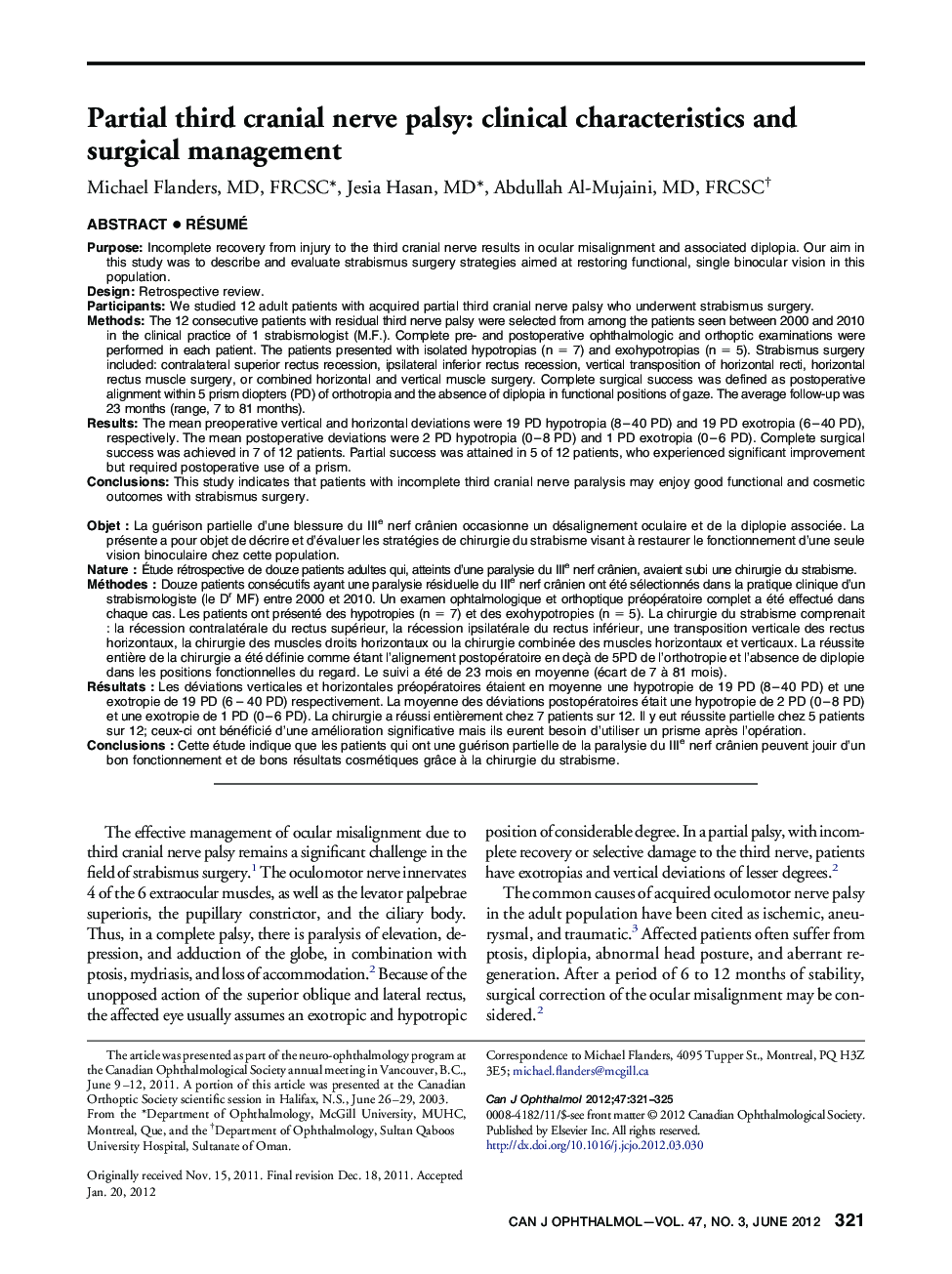| کد مقاله | کد نشریه | سال انتشار | مقاله انگلیسی | نسخه تمام متن |
|---|---|---|---|---|
| 4009659 | 1602415 | 2012 | 5 صفحه PDF | دانلود رایگان |

PurposeIncomplete recovery from injury to the third cranial nerve results in ocular misalignment and associated diplopia. Our aim in this study was to describe and evaluate strabismus surgery strategies aimed at restoring functional, single binocular vision in this population.DesignRetrospective review.ParticipantsWe studied 12 adult patients with acquired partial third cranial nerve palsy who underwent strabismus surgery.MethodsThe 12 consecutive patients with residual third nerve palsy were selected from among the patients seen between 2000 and 2010 in the clinical practice of 1 strabismologist (M.F.). Complete pre- and postoperative ophthalmologic and orthoptic examinations were performed in each patient. The patients presented with isolated hypotropias (n = 7) and exohypotropias (n = 5). Strabismus surgery included: contralateral superior rectus recession, ipsilateral inferior rectus recession, vertical transposition of horizontal recti, horizontal rectus muscle surgery, or combined horizontal and vertical muscle surgery. Complete surgical success was defined as postoperative alignment within 5 prism diopters (PD) of orthotropia and the absence of diplopia in functional positions of gaze. The average follow-up was 23 months (range, 7 to 81 months).ResultsThe mean preoperative vertical and horizontal deviations were 19 PD hypotropia (8–40 PD) and 19 PD exotropia (6–40 PD), respectively. The mean postoperative deviations were 2 PD hypotropia (0–8 PD) and 1 PD exotropia (0–6 PD). Complete surgical success was achieved in 7 of 12 patients. Partial success was attained in 5 of 12 patients, who experienced significant improvement but required postoperative use of a prism.ConclusionsThis study indicates that patients with incomplete third cranial nerve paralysis may enjoy good functional and cosmetic outcomes with strabismus surgery.
RésuméObjetLa guérison partielle d’une blessure du IIIe nerf crânien occasionne un désalignement oculaire et de la diplopie associée. La présente a pour objet de décrire et d’évaluer les stratégies de chirurgie du strabisme visant à restaurer le fonctionnement d’une seule vision binoculaire chez cette population.NatureÉtude rétrospective de douze patients adultes qui, atteints d’une paralysie du IIIe nerf crânien, avaient subi une chirurgie du strabisme.MéthodesDouze patients consécutifs ayant une paralysie résiduelle du IIIe nerf crânien ont été sélectionnés dans la pratique clinique d’un strabismologiste (le Dr MF) entre 2000 et 2010. Un examen ophtalmologique et orthoptique préopératoire complet a été effectué dans chaque cas. Les patients ont présenté des hypotropies (n = 7) et des exohypotropies (n = 5). La chirurgie du strabisme comprenait : la récession contralatérale du rectus supérieur, la récession ipsilatérale du rectus inférieur, une transposition verticale des rectus horizontaux, la chirurgie des muscles droits horizontaux ou la chirurgie combinée des muscles horizontaux et verticaux. La réussite entière de la chirurgie a été définie comme étant l’alignement postopératoire en deçà de 5PD de l’orthotropie et l’absence de diplopie dans les positions fonctionnelles du regard. Le suivi a été de 23 mois en moyenne (écart de 7 à 81 mois).RésultatsLes déviations verticales et horizontales préopératoires étaient en moyenne une hypotropie de 19 PD (8–40 PD) et une exotropie de 19 PD (6 – 40 PD) respectivement. La moyenne des déviations postopératoires était une hypotropie de 2 PD (0–8 PD) et une exotropie de 1 PD (0–6 PD). La chirurgie a réussi entièrement chez 7 patients sur 12. Il y eut réussite partielle chez 5 patients sur 12; ceux-ci ont bénéficié d’une amélioration significative mais ils eurent besoin d’utiliser un prisme après l’opération.ConclusionsCette étude indique que les patients qui ont une guérison partielle de la paralysie du IIIe nerf crânien peuvent jouir d’un bon fonctionnement et de bons résultats cosmétiques grâce à la chirurgie du strabisme.
Journal: Canadian Journal of Ophthalmology / Journal Canadien d'Ophtalmologie - Volume 47, Issue 3, June 2012, Pages 321–325